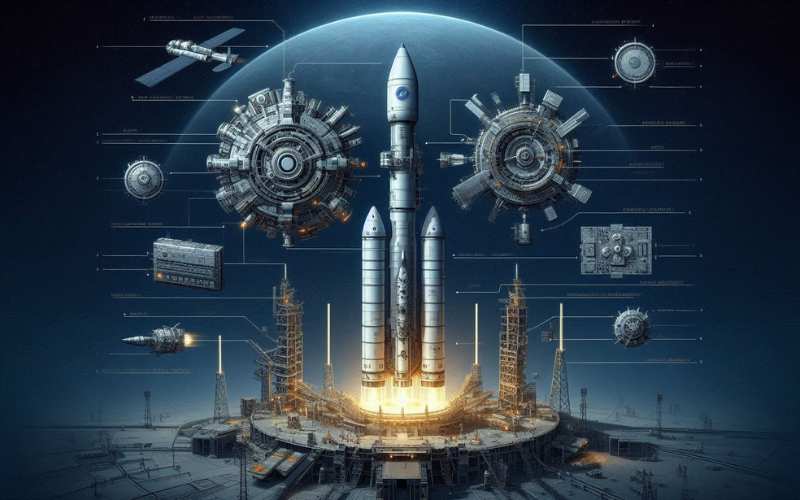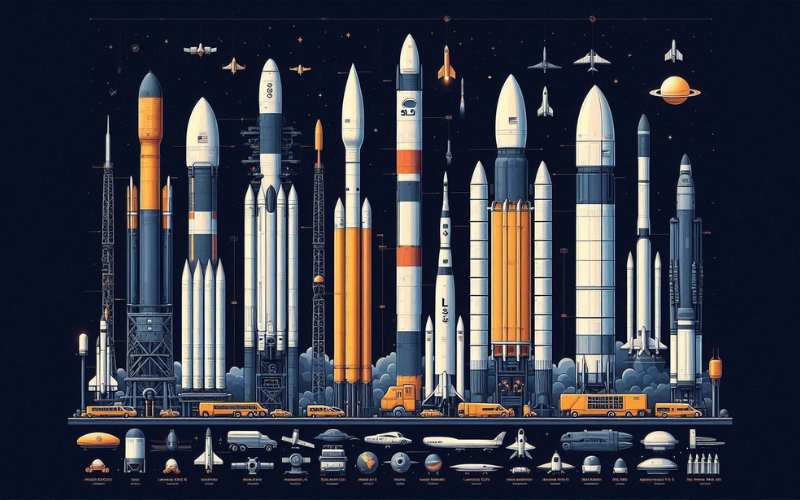The Space Launch System (SLS) is NASA’s next-generation heavy-lift rocket, designed specifically for deep space exploration and set to become the backbone of NASA’s missions beyond Earth’s orbit. Created as part of NASA’s Artemis program, the SLS represents NASA’s vision to send astronauts back to the Moon and, eventually, to Mars and other distant destinations. As NASA’s most powerful rocket, the SLS is crucial for transporting large payloads, life-supporting systems, and astronauts on missions that will redefine humanity’s role in space.
Why the Space Launch System is a Game Changer

The SLS is built to achieve what previous rockets could not: reaching beyond low Earth orbit (LEO) to support human exploration of deep space. While rockets like the Space Shuttle and even the Saturn V (used during the Apollo program) were groundbreaking, they lacked the capabilities needed for interplanetary missions. By comparison, the SLS is designed for crewed deep-space missions with unmatched lift capacity, making it uniquely suited for missions to the Moon, Mars, and beyond. As the most powerful rocket NASA has ever developed, the SLS brings together decades of engineering expertise and innovation, marking a new era in space exploration.
Key Features of the Space Launch System (SLS)

The SLS’s design integrates advanced technology from previous NASA programs, enhanced to support the extreme demands of deep-space travel. Here’s what makes the SLS unique:
- Core Stage and RS-25 Engines
The core stage of the SLS stands over 200 feet tall, containing four powerful RS-25 engines derived from the Space Shuttle. Fueled by liquid hydrogen and liquid oxygen, these engines generate over 2 million pounds of thrust at launch, propelling the rocket beyond Earth’s atmosphere. - Solid Rocket Boosters (SRBs)
Flanking the core stage are two solid rocket boosters, each providing an additional 3.6 million pounds of thrust. These boosters are adapted from the Space Shuttle’s design, delivering the initial boost needed to escape Earth’s gravity. Together, the core stage and boosters generate more power than any other NASA rocket, enabling missions to the Moon, Mars, and beyond. - Interim Cryogenic Propulsion Stage (ICPS)
The ICPS serves as an upper stage, providing the final push for the SLS to reach deep-space destinations. Powered by a single RL10 engine, it ensures precise trajectory adjustments, essential for long-duration missions to locations like the Moon and Mars. - Orion Crew Capsule
At the top of the SLS is the Orion crew capsule, NASA’s state-of-the-art spacecraft for astronaut transport. Equipped with advanced life support, navigation, and radiation shielding, Orion can sustain up to four astronauts on extended missions, offering safety and resilience for deep-space travel.
Versatile Configurations for Multiple Missions
The SLS is built to evolve, with various configurations to support a range of missions:
- Block 1: Capable of carrying over 27 metric tons to deep space, Block 1 is set to support Artemis I, an uncrewed mission that will send Orion around the Moon.
- Block 1B: With the Exploration Upper Stage (EUS), Block 1B increases payload capacity to over 38 metric tons, supporting more complex lunar missions.
- Block 2: Planned for future Mars missions, Block 2 is designed to carry over 45 metric tons to deep space, making it ideal for crewed interplanetary missions.
How the SLS Compares to Other Rockets

The SLS is frequently compared to other heavy-lift rockets, such as SpaceX’s Falcon Heavy and Starship as well as NASA’s Saturn V. While each has unique features, the SLS stands out in key areas:
- Saturn V: NASA’s Saturn V was the first rocket to send humans to the Moon. The SLS builds on this legacy, with configurations like Block 2 designed to support missions beyond the Moon, potentially to Mars.
- Falcon Heavy: SpaceX’s Falcon Heavy, with a 64 metric ton capacity to LEO, is powerful but primarily focused on Earth orbit and lunar flybys. The SLS, however, is engineered for crewed deep-space missions.
- Starship: Still in development, SpaceX’s Starship aims for reusability and large payload capacity. However, the SLS is NASA’s choice for the Artemis program, built specifically to meet the demands of crewed missions to deep-space destinations.
The Space Launch System’s Role in NASA’s Goals
- Supporting the Artemis Program
As the primary vehicle of the Artemis program, the SLS will launch the Orion capsule to the Moon on Artemis I, an uncrewed test mission, followed by Artemis II, a crewed mission around the Moon. Artemis III aims to land humans on the lunar surface, establishing a sustainable human presence there. - Preparing for Mars Missions
Beyond the Moon, the SLS is vital for NASA’s long-term vision of reaching Mars. Its future configurations are capable of supporting the heavy logistics required for a Mars mission, including habitats, life support, and fuel reserves, which will be essential for human exploration of the Red Planet. - Expanding Scientific Discovery
With unmatched payload capacity, the SLS can launch large scientific equipment and interplanetary probes to study regions beyond our solar system. Missions enabled by the SLS could advance our understanding of distant moons, planets, and asteroids, opening up unprecedented scientific research opportunities. - International and Commercial Collaboration
The SLS is at the center of NASA’s global partnerships, especially in the Artemis program, which includes the European Space Agency (ESA) and other international collaborators. These partnerships aim to develop a robust space exploration ecosystem, setting the stage for future missions to Mars. - Pushing Technological Boundaries
The development of the SLS has led to innovations in rocket design, propulsion, and safety systems. These advancements will not only benefit NASA’s missions but may also drive future technologies in commercial space exploration and even sustainable life support for long-term space habitation.
In summary, the Space Launch System is more than a rocket—it’s a critical element in NASA’s vision for space exploration. With its powerful design, adaptability, and alignment with NASA’s long-term goals, the SLS is positioned to become humanity’s gateway to the Moon, Mars, and the vast expanses beyond, helping to unlock the mysteries of the universe.


